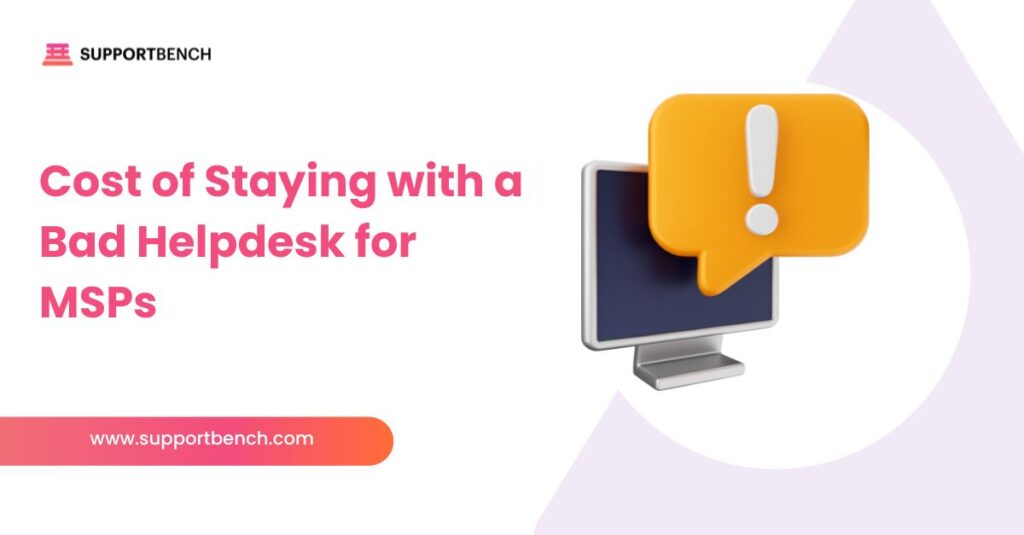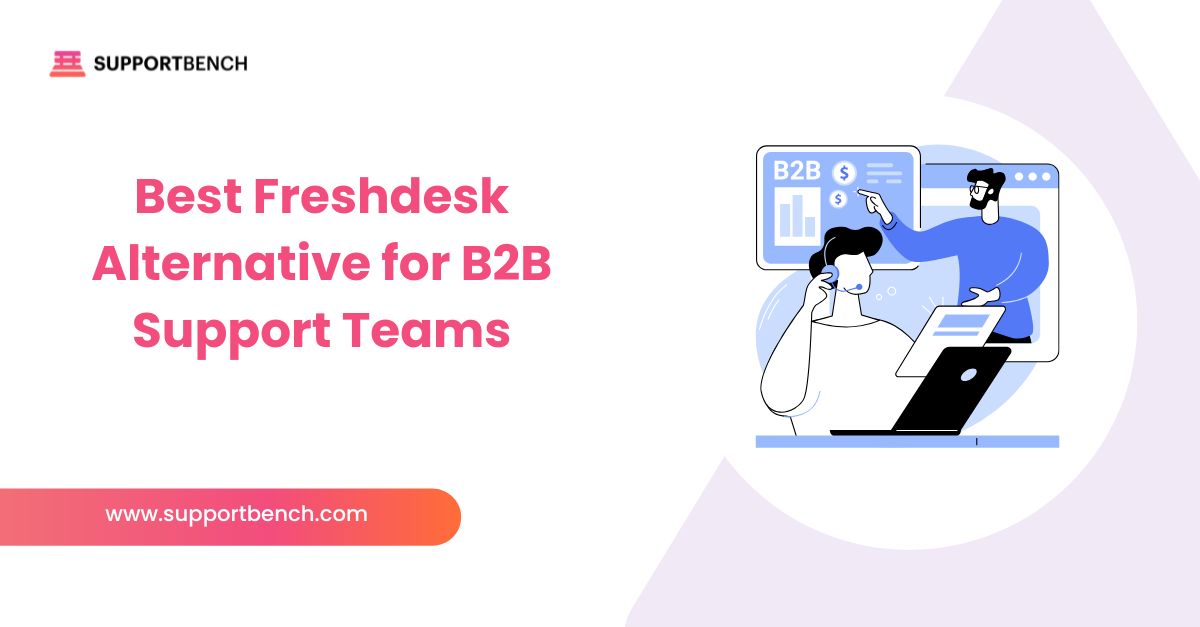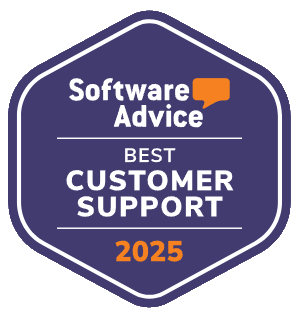Picture an MSP or IT support team using the same helpdesk for years. Complaints pile up, SLAs slip, and agents spend extra minutes on every ticket—but switching platforms feels like too much disruption.
On the surface, sticking with the familiar tool seems low-risk. In reality, the cost of a bad helpdesk is far higher than most leaders realize. Productivity loss, SLA penalties, agent turnover, and unhappy clients quietly add up month after month.
This blog breaks down the hidden financial, operational, and customer experience costs of staying with an underperforming helpdesk. It also shows what signs to watch for, when it’s time to switch, and how modern solutions—like Supportbench—make the transition far easier than expected.
At a Glance:
Staying with a bad helpdesk drains resources through lost productivity, SLA penalties, staff turnover, and client churn. Operational bottlenecks like weak automation, poor integrations, and lack of reporting make matters worse, while competitors using modern tools pull ahead. Switching to a platform like Supportbench eliminates these inefficiencies with SLA tracking, automation, sentiment analysis, and seamless integrations—helping teams save money, retain clients, and scale with confidence.
The Hidden Financial Costs

An outdated helpdesk drains resources in ways that often go unnoticed. From wasted staff hours to lost revenue and higher turnover, the costs accumulate quickly.
Lost Agent Productivity
Every extra minute spent navigating slow systems or handling repetitive tasks is time not spent solving client issues. Multiply that by hundreds of tickets per month, and the numbers climb fast.
For example, if agents waste five minutes per ticket and your team handles 500 tickets monthly, that’s more than 40 hours lost—an entire workweek gone to inefficiency.
Revenue Leakage and SLA Penalties
When SLAs are missed, consequences ripple beyond a single ticket. Contractual penalties, failed renewals, and damaged trust all cut into revenue. In industries with strict uptime or response requirements, these breaches directly translate into financial loss.
Staff Turnover Costs
Frustrated agents are more likely to leave when they’re stuck with tools that slow them down. Replacing even one experienced technician can cost thousands in recruitment, training, and lost productivity. High turnover also disrupts service quality, making it harder to maintain client trust.
➤ Pro Tip: Many MSPs that move from legacy tools to Supportbench report measurable cost savings through better SLA compliance, faster ticket handling, and reduced staff churn.
The Operational Bottlenecks

Bad helpdesks don’t just waste money—they create daily roadblocks that slow down entire teams.
Manual Workflows and Weak Automation
Without automation, agents spend time reassigning tickets, chasing reminders, and manually escalating cases. These tasks delay resolutions and contribute to missed SLAs.
Supportbench addresses this with workflow automation, SLA alerts, and built-in escalation rules—so routine work happens automatically and agents can focus on clients.
Integration Gaps
When a helpdesk doesn’t integrate with CRM, PSA, or monitoring tools, staff are forced to re-enter data across systems. This not only wastes time but also increases errors.
Supportbench bridges these gaps with native integrations and APIs that sync client data, contract details, and ticket history seamlessly.
Lack of Visibility
Without dashboards or real-time reporting, leaders are left guessing where performance is slipping. Hidden SLA breaches or growing ticket backlogs often go unnoticed until it’s too late.
Supportbench eliminates this blind spot with real-time dashboards, KPI scorecards, and SLA tracking tools that give decision-makers full visibility.
The Customer Experience Impact

When a helpdesk underperforms, the client experience suffers. Over time, this erodes trust and drives customers to look elsewhere.
Inconsistent Responses
Without standardized workflows, some tickets get thorough answers while others are rushed or incomplete. This inconsistency leaves clients questioning reliability.
Delays in Resolution
A lack of prioritization tools means urgent cases may sit unresolved while minor issues get attention first. These delays frustrate clients and raise the risk of churn.
Erosion of Trust
Missed SLAs, slow updates, and poor communication combine to weaken confidence in your services. Once trust is lost, renewals and referrals are much harder to secure.
Supportbench helps avoid these pitfalls with automated routing, AI-powered ticket summarization, and built-in sentiment tracking—tools that keep responses consistent, fast, and aligned with client expectations.
The Competitive Disadvantage

Clients compare service providers constantly. If competitors use modern helpdesks with faster responses, real-time dashboards, and transparent reporting, they’ll set a higher standard that outdated systems can’t match.
An inefficient helpdesk doesn’t just slow your team—it makes you look less capable compared to rivals. Missed SLAs, poor visibility, and inconsistent service become reasons clients switch providers.
Supportbench equips MSPs and IT teams with automation, SLA compliance tools, sentiment analysis, and integrated reporting—giving you the ability to meet or exceed those benchmarks and retain your competitive edge.
How to Evaluate If It’s Time to Switch

Recognizing when a helpdesk is holding you back is the first step toward improving performance and ROI.
Common Warning Signs
- Frequent SLA breaches or delayed escalations
- Agents struggling to adopt the system
- Reports that arrive late or don’t reflect reality
- Limited or missing integrations with PSA, CRM, or monitoring tools
- Client sentiment issues that go unnoticed until complaints surface
Self-Assessment Checklist
Ask yourself:
- How many SLAs are missed each month?
- Do agents spend extra minutes on every ticket due to slow tools?
- Is reporting consistent, accurate, and timely?
- Are integrations creating seamless workflows—or forcing manual re-entry?
- Is churn or client dissatisfaction linked to support delays?
If several of these sound familiar, the cost of staying with a bad helpdesk is already compounding.
For a deeper evaluation, see our guide on choosing the right helpdesk for your MSP.
Transitioning Without Disruption

Upgrading your helpdesk may feel risky, but the transition can be smooth with the right platform and support. The short-term effort is far outweighed by long-term gains in efficiency, morale, and client satisfaction.
What a Modern Transition Looks Like
- Migration Tools: Transfer ticket history, user data, and configurations without losing context.
- Structured Onboarding: Step-by-step setup ensures teams know how to use the system from day one.
- Seamless Integrations: Connect existing IT systems—CRM, PSA, monitoring—so workflows stay intact.
- Dedicated Support: Guidance from experts to troubleshoot and optimize as you adapt.
Supportbench provides these resources out of the box, helping MSPs and IT teams switch confidently without downtime.
For more on building a future-ready platform, see our MSP helpdesk requirements checklist.
Conclusion
The cost of staying with a bad helpdesk goes far beyond minor inconvenience. Lost productivity, SLA breaches, agent frustration, and declining client trust all translate into measurable financial and reputational damage. Left unchecked, these issues compound month after month—holding your business back while competitors move ahead.
It’s not just about avoiding losses; it’s about unlocking efficiency, improving client satisfaction, and enabling growth.
Supportbench gives MSPs and IT teams the tools to break free from outdated systems—automation, SLA tracking, sentiment analysis, and seamless integrations—all backed by onboarding and migration support that makes switching painless.
Book a personalized demo today to see how upgrading your helpdesk with Supportbench can save time, money, and clients.















